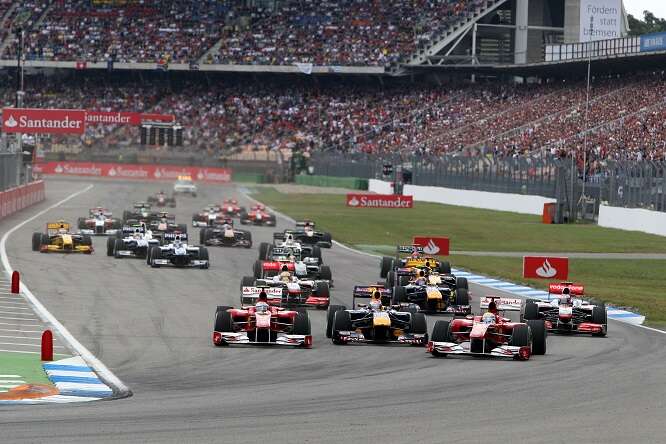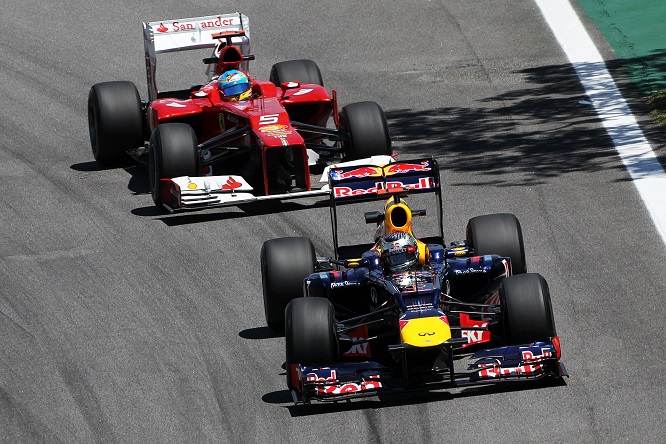By Carlo Platella
“At the moment we are not only fighting against Vettel, but also against Newey”. Words, those uttered by Fernando Alonso during the years of the world championship challenges between Red Bull and Ferrari, which encapsulate the sense of an atypical rivalry. A driver and an engineer who fought for the world title three times, before joining forces to try to bring Aston Martin to the top of the world.
The beginning
It was 2005 when Alonso and Newey were the protagonists of their first duel for the world title. It is a year of regulatory changeswith the Federation prescribing an increase in the height of the front wing of 50 mm. This is a significant headache for the teams, as the raised wing, in addition to losing aerodynamic load, causes the vortices generated at its ends to impact the lower suspension arms, destroying the flows directed towards the bottom and the rest of the car.
Adrian Newey, then in uniform with McLaren, reacted to the problem by raising the lower suspension triangle by another 120 mm, compromising its kinematics, but ensuring an important aerodynamic advantage. An idea that the British designer came up with during a holiday in Barbados, from where he communicated remotely with the Woking headquarters. “I was sending a lot of faxes, trying to find a solution to the conflict between aerodynamic utopia and the resulting structural and packaging difficulties”, Newey recounts in his autobiographical book “How to Build a Car”.
The 2005 MP4 20, however, had another ace up its sleeve, namely the innovative instant-shift transmission designed by Giles Wood and Tim Goss, which was soon to revolutionise Formula 1. That season, McLaren and Adrian Newey won 10 out of 17 races, but were disappointed by the many points lost due to reliability. The world titles were thus won by Renault and Fernando Alonsoalso supported by the controversial system mass damper introduced at the end of the championship. Kimi Raikkonen, fighting for the world championship until the last race, had to settle for second place.
The Revenge
Newey and Alonso crossed swords again in 2010, with the former in the Red Bull colours and the latter as the new standard-bearer for Ferrari. The Spaniard, at the wheel of the F10, found himself up against the Milton Keynes RB6s, for which the English engineer dusts off an idea already tested in McLaren during the previous world championship challenge in 2005. Starting from Sepang, Red Bull has been using a system that hydraulically connects the two suspensions, so as to limit the sinking of the front end with every jolt of the rear. All this ensures excellent stabilization of the heights and posture with respect to the ground, enhancing the aerodynamics of the surface.

It is always Newey who then finds a way to exploit the energy of the exhaust gases again to help extract air from the diffuser, a system already used in Formula 1 in the past, but severely limited after the Imola tragedies of 1994. With the new single-seaters equipped with a double diffuser in fact, first designed by Brawn GP in 2009, the exhaust ducts manage to blow the hot gases right near the upper hole opened in the diffuser.an opportunity that Newey does not let slip. Despite the extraordinary qualities of the Red Bulls, however, Fernando Alonso and Ferrari kept Maranello’s hopes alive until the decisive appointment in Abu Dhabi, with Mark Webber as the main opponent and Sebastian Vettel ready to take advantage of every opportunity. The rest is history.
The last meeting
The battle between the two contenders took place two years later, with Fernando Alonso able to extract every possible millisecond from his Ferrari F2012. For the Red Bull RB8, Adrian Newey opted for a direct evolution of the dominant 2011 car, reproposing its winning ideas. With the double diffuser now banned, Newey Finds New Use for Blower ExhaustsThis time the gases do not inject energy directly into the diffuser, but protect it laterally, crushing the harmful vortices generated by the rear wheels to the ground.
Red Bull can thus afford a very low set-up – rake -, raising the rear end to generate additional downforce from the diffuser. All this enhances a further insight from Neweywhich, against internal skepticism, insists on installing the KERS battery in front of the gearbox, so as to move the engine even further forward. A choice that compromises the reliability of the system, but which ensures Red Bull a tapered rear end that is very advantageous from an aerodynamic point of view.

The 2012 RB8 embodies all of this. The Federation’s attempt to limit the blowing exhausts by imposing their raised installation in the car is of little use. In fact, Red Bull has come up with a body with sliding belliesso as to direct the hot gases adhering to the surfaces towards the desired area. The stubbornness of Alonso and Ferrari still keeps the championship alive until the last race in Brazil, when however it is once again Vettel, Red Bull and Newey who celebrate.
The common mission
Twenty years after their first challenge, Fernando Alonso and Adrian Newey meet again as allies, trying to fulfill the Spanish driver’s dream of winning a third world title after being deprived of it by the British engineer himself. The big opportunity is 2026, in a regulation that foresees bulkier power units, smaller cars and where the arrangement of internal components will be crucial, a challenge where Newey’s insights will be invaluable. Alonso for his part will try to make all his cunning count, at the wheel of cars where even more than now the drivers will have to be skilled at managing energy and on-board systems. A pair of Formula 1 veterans, who now have the opportunity to work together for the same goal that they have been fighting for years.
#McLarenRenault #Red #BullFerrari #World #Challenges #Newey #Alonso
